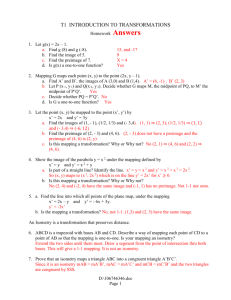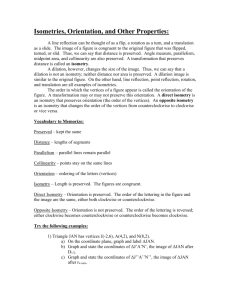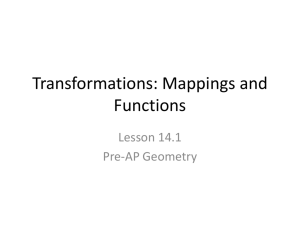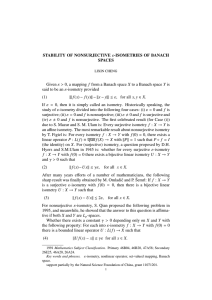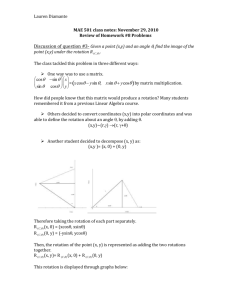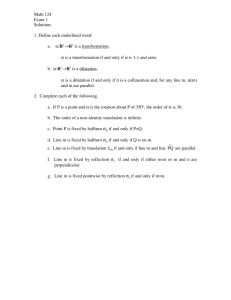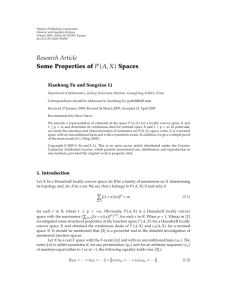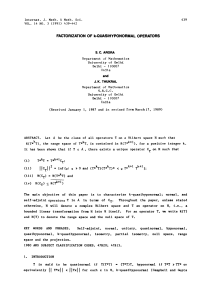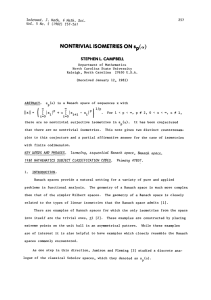Bulletin of Mathematical Analysis and Applications ISSN: 1821-1291, URL:
advertisement
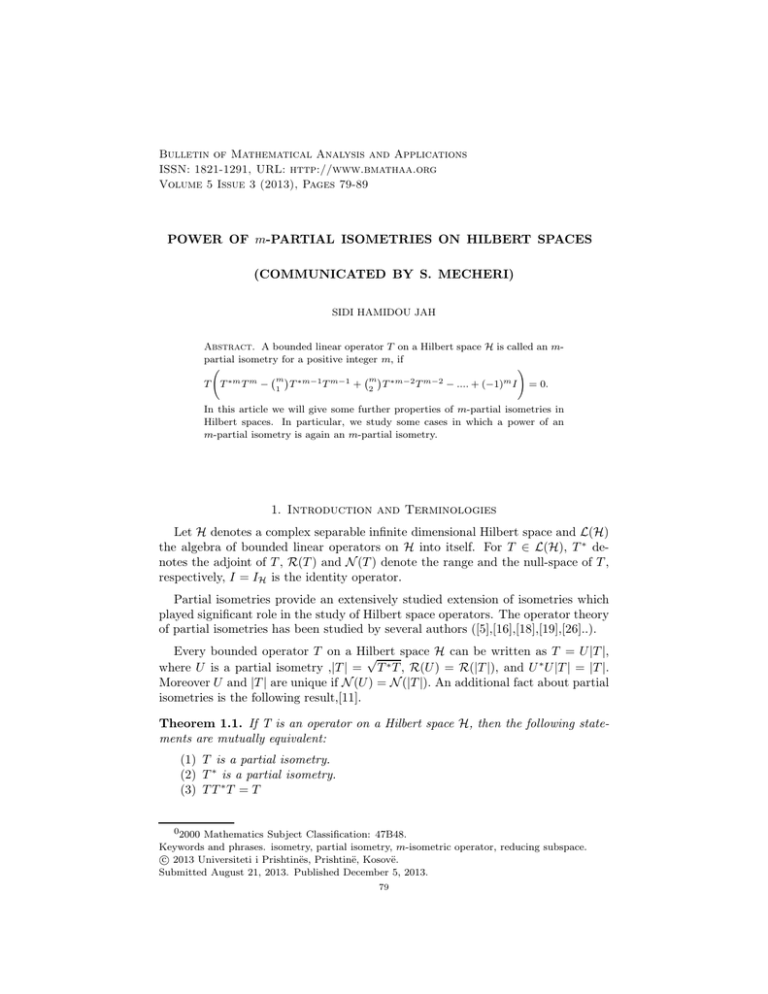
Bulletin of Mathematical Analysis and Applications
ISSN: 1821-1291, URL: http://www.bmathaa.org
Volume 5 Issue 3 (2013), Pages 79-89
POWER OF m-PARTIAL ISOMETRIES ON HILBERT SPACES
(COMMUNICATED BY S. MECHERI)
SIDI HAMIDOU JAH
Abstract. A bounded linear operator T on a Hilbert space H is called an mpartial isometry for a positive integer m, if
!
m ∗m−1 m−1
m ∗m−2 m−2
∗m m
m
T T
T − 1 T
T
+ 2 T
T
− .... + (−1) I = 0.
In this article we will give some further properties of m-partial isometries in
Hilbert spaces. In particular, we study some cases in which a power of an
m-partial isometry is again an m-partial isometry.
1. Introduction and Terminologies
Let H denotes a complex separable infinite dimensional Hilbert space and L(H)
the algebra of bounded linear operators on H into itself. For T ∈ L(H), T ∗ denotes the adjoint of T , R(T ) and N (T ) denote the range and the null-space of T ,
respectively, I = IH is the identity operator.
Partial isometries provide an extensively studied extension of isometries which
played significant role in the study of Hilbert space operators. The operator theory
of partial isometries has been studied by several authors ([5],[16],[18],[19],[26]..).
Every bounded operator T on a Hilbert
space H can be written as T = U |T |,
√
where U is a partial isometry ,|T | = T ∗ T , R(U ) = R(|T |), and U ∗ U |T | = |T |.
Moreover U and |T | are unique if N (U ) = N (|T |). An additional fact about partial
isometries is the following result,[11].
Theorem 1.1. If T is an operator on a Hilbert space H, then the following statements are mutually equivalent:
(1) T is a partial isometry.
(2) T ∗ is a partial isometry.
(3) T T ∗ T = T
02000 Mathematics Subject Classification: 47B48.
Keywords and phrases. isometry, partial isometry, m-isometric operator, reducing subspace.
c 2013 Universiteti i Prishtinës, Prishtinë, Kosovë.
Submitted August 21, 2013. Published December 5, 2013.
79
80
SIDI HAMIDOU JAH
J. Agler and M.Stankus studied another extension called m-isometries on Hilbert
space. An operator T ∈ L(H) is an m-isometry for some integer m ≥ 1 if
m
X
m ∗m−k m−k
T
T
= 0,
(1)
(−1)k
k
k=0
where m
is the binomial coefficient. Simple manipulation proves that (1.1) is
k
equivalent to
m
X
k m
kT m−k xk2 = 0, for all x ∈ H
(2)
(−1)
k
k=0
Evidently, an isometric operator (i.e., a 1-isometric operator) is m-isometric for all
integers m ≥ 1. Indeed the class of m-isometric operators is a generalization of the
class of isometric operators. A detailed study of this class, in particular 2-isometric
operators on a Hilbert space has been the object of some intensive study, especially
by J.Agler and M. Stankus in [1], [2] and [3], but also by S.Richter [23], Shimorin
[27] ,S.M. Patel [22] and C.Hillings [17], J.Gleasum and S.Richter [15]. Also we refer
the reader to [10, 12, 13, 14] for more information about m− isometric operators on
Hilbert space. m-Isometries are not only a natural extension of an isometry, but
they are also important in the study of Dirichlet operators and some other classes
of operators.
The following characterization of 3-isometry is given by M. Scott in [25]. An operator T ∈ L(H) is a 3-isometry if
T ∗3 T 3 − 3T ∗2 T 2 + 3T ∗ T − I = 0.
Equivalently T is a 3-isometry if and only if there exist operators B1 (T ∗ , T ) and
B2 (T ∗ , T ) such that for all natural numbers n,
T ∗n T n = I + nB1 (T ∗ , T ) + n2 B2 (T ∗ , T ).
(3)
In this case it is straightforward to verify that
and
∗
2B2 (T ∗ , T ) = T ∗2 T 2 − 2T ∗ T + I
(4)
2B1 (T ∗ , T ) = −T ∗2 T 2 + 4T ∗ T − 3I.
(5)
Evidently, each Bj (T , T ) is self-adjoint.
The notion of m-isometric operators on Hilbert spaces has been generalized to
operators on general Banach spaces in papers of Botelho [8], Sid Ahmed [20], [21]
and Bayart [4]. An operator T ∈ L(X) on a Banach space X is called an (m, p)isometry if there exists an integer m ≥ 1 and a p ∈ [1, ∞), with
m
X
k m
kT m−k xkp = 0
(6)
∀ x ∈ X,
(−1)
k
k=0
It is easy to see that, if X = H is a Hilbert space and p = 2, this definition coincides
with the original definition (1.1) of m-isometries.
Recall that T ∈ L(H) is normal if it satisfies the following condition: T ∗ T = T T ∗,
quasi-normal if: T (T ∗T ) = (T ∗ T )T and quasi-isometry if T ∗2 T 2 = T ∗ T.
POWER OF m-PARTIAL ISOMETRIES ON HILBERT SPACES
81
In [24] Adel and Sid Ahmed considered an extension of the notion of partial
isometries to m-partial isometries. We say that T ∈ L(H) is an m-partial isometry
if T satisfies
m X
m
T Bm (T ) = T
(−1)k T ∗m−k T m−k = 0,
(7)
k
k=0
where Bm (T ) is obtained formally from the binomial expansion of Bm (T ) = (T ∗ T − I)m
m−k
by understanding (T ∗ T )
= T ∗m−k T m−k . The case when m = 1 is the partial
isometries class. The class of m-partial isometries properly contains class of misometries. Contrary to the case of quasi-normal operators, in general, the kernel
of an m-partial isometry is not reducing. Adel and Sid Ahmed [24] have proved the
following interesting results: if T is an m-partial isometry such that the null space
N (T ) of T is a reducing subspace for T , and ST is defined by ST := T ∗ Bm−1 (T )T ,
then ST is positive , N (ST ) is invariant subspace for T and T/N (ST ) is an (m − 1)partial isometry. Furthermore, if M is an invariant subspace for T and T/M is
(m − 1)-partial isometry, then M ⊂ N (ST ). In addition if m = 2 and T is a finitely
cyclic, then T is compact.
A subspace M of H is called a reducing subspace for T if both M and M⊥ are
T −invariant or equivalently if M is invariant for both T and T ∗ .
Theorem 1.2. ( [24] ) If T ∈ L(H) and N (T ) is a reducing subspace for T , then
the following properties are equivalent
(1) T is an m-partial isometry.
(2) T |N (T )⊥ is an m-isometry.
Remark 1.3. The assertion (2) in Theorem 1.2 is equivalent to
m
m
kT mT ∗ xk2 −
kT T ∗xk2 +(−1)m kT ∗xk2 = 0, ∀ x ∈ H.
kT m−1 T ∗ xk2 +...+(−1)m−1
m−1
1
The following proposition gives a more detailed description of several spectral
properties of some m- partial isometries concerning the approximate spectrum σap ,
the spectrum σ(T ) and the point spectrum σp .
Proposition 1.4. ([24]) If T ∈ L(H) is an m-partial isometry such that the null
space N (T ) of T is a reducing subspace for T , then
(1) σap (T ) ⊂ ∂D ∪ {0}, where D is the unit disc of the complex plane C.
(2) σ(T ) ⊂ ∂D or σ(T ) = D.
(3) λ ∈ σap (T )\{0} implies that λ ∈ σap (T ∗ ), i.e., if (T − λ)xn −→ 0 for some
bounded sequence {xn } ⊂ H : kxn k = 1, then (T − λ)∗ xn −→ 0.
(4) λ ∈ σp (T )\{0} implies that λ ∈ σp (T ∗ ).
(5) Eigenvectors of T corresponding to distinct eigenvalues are orthogonal, i.e.
N (T − λ)⊥N (T − µ) if λ, µ ∈ σp (T ) and λ 6= µ.
2. Main Results
Theorem 2.1. Let T, N ∈ L(H) such that T is an invertible m-isometry, T N =
N T , T N ∗ = N ∗ T and N 2 = 0. Then T + N is an (m + 2)- isometry.
82
SIDI HAMIDOU JAH
Proof. To prove that T + N is an (m + 2)-isometry, we need to prove that
m+2
X
k m+2
(T ∗ + N ∗ )m+2−k (T + N )m+2−k = 0.
(−1)
k
k=0
From [20] , we have T −1 is an m-isometry and T is an (m + 1)-isometry. It
follows that
m+2
X
m+2
(T ∗ + N ∗ )m+2−k (T + N )m+2−k
k
k=0
X
m+2
1 1 X
X
m+2−k
m+2
m+2−k
T m+2−k−j N j
T ∗m+2−k−j N ∗j
=
(−1)k
j
k
j
j=0
j=0
(−1)k
k=0
=
m+2
X
(−1)k
k=0
m+ 2
T m+2−k +(m+2−k)T m+1−kN .
T ∗m+2−k +(m+2−k)T ∗m+1−kN ∗
k
Simple computation gives
m+1
m+2
X
X
m + 1 ∗m+1−k m+1−k −1
m+2
T
T
T N = 0,
kT ∗m+2−k T m+1−k N = −(m+2)
(−1)k
(−1)k
k
k
k=0
k=0
and
m+2
X
m + 2 2 ∗m+1−k ∗ m+1−k
k T
N T
N
k
k=0
m+2
X
m+2
(k(k−1)+k)T ∗m+1−k N ∗ T m+1−k N
=
(−1)k
k
k=1
m
X
∗ −1
k m
= (m + 2)(m + 1)(T )
(−1)
T ∗m−k T m−k N ∗ T −1 N
k
(−1)k
k=0
= 0.
We deduce that
m+2
X
k m+2
(T ∗ + N ∗ )m+2−k (T + N )m+2−k = 0.
(−1)
k
k=0
Hence, the result.
Proposition 2.2. If T is an m-partial isometry such that T k is an partial isometry
for k = 1, 2, 3, ...m − 1, then T m is a partial isometry for m ≥ 2.
Proof. Since T is an m-partial isometry, we have
T T
∗m
T
m
−
∗m−1 m−1
(m
T
1 )T
+
∗m−2 m−2
(m
T
2 )T
m
− .... + (−1) I
!
= 0.
Multiplying the above equation from the left by T m−1 we get
m ∗m−1 m−1
m ∗m−2 m−2
T m T ∗m T m − (m
T
+ (m
T
− .... + (−1)m T m = 0.
1 )T T
2 )T T
POWER OF m-PARTIAL ISOMETRIES ON HILBERT SPACES
83
Since T k is a partial isometry for k = 1, ..., m − 1, we deduce that
m
m
T m T ∗m T m − (m
+ (m
− .... + (−1)m T m = 0.
1 )T
2 )T
Thus,
m
T T
∗m
T
m
+T
m
−
(m
1 )
+
(m
2 )....
m
+ (−1)
!
= 0.
Hence
T m T ∗m T m = T m .
Remark 2.3. The conditions on T k in Proposition 2.2 are necessary as shown in
the following example.
0 q 0
0
√
1+ 5
Example 2.4. Consider the operator S = 0
0 ,
2
0
1
0
acting on C3 . Simple calculation shows that S is a 2-partial isometry but S is
not a 1-partial isometry. Therefore S 2 is not a partial isometry (see [24]).
Proposition 2.5. Let T ∈ L(H) be an m-partial isometry such that T k is a partial
isometry for k = 2, 3, ..., m. Then
T m = T m T ∗ T.
Proof. We have
T T
∗m
T
m
−
m ∗m−1 m−1
T
T
1
+
m ∗m−2 m−2
T
T
2
m
− .... + (−1) I
!
= 0.
Multiplying the above equation from the left by T m−1 , we obtain
T m T ∗m T m −
m m ∗m−1 m−1
T T
T
1
+
m m ∗m−2 m−2
T T
T
2
m ∗
m m
= 0.
− .... + (−1)m−1 (m
m−1 )T T T + (−1) T
By the assumption we get
m
m
m ∗
m m
T m − 1 T m + 2 T m − .... + (−1)m−1 (m
= 0.
m−1 )T T T + (−1) T
A simple computation shows that T m (I − T ∗ T ) = 0. Hence, the result.
Remark 2.6. It is known that if T is an m-partial isometry such that T is a
quasi-isometry or a quasi-normal , then T is a partial isometry ( [24] ).
The general case is given in the following corollary.
Corollary 2.7. Let T ∈ L(H) be an m-partial isometry such that T k is a partial
isometry for k = 2, 3, ..., m. If N (T ) = N (T 2 ), then T is a partial isometry.
Proof. It is a consequence of Proposition 2.2 and the fact that N (T ) = N (T n )
for all positive integer n.
Proposition 2.8. Let T ∈ L(H) be an 2-partial isometry and an 3-partial isometry.
Then the power of T satisfies the following relation
kT k xk2 = (k − 1)kT 2xk2 − (k − 2)kT xk2, k = 1, 2, 3, .....
(8)
84
SIDI HAMIDOU JAH
Proof. Since T is an 2-partial isometry and an 3-partial isometry, we obtain
T T ∗2 T 2 − 2T ∗ T + I = 0,
(9)
and
∗3 3
∗2 2
∗
T T T − 3T T + 3T T − I = 0.
(10)
From (2.2) and (2.3), we deduce that
T T ∗(T ∗2 T 2 − 2T ∗ T + I)T = 0,
or
T ∗ (T ∗2 T 2 − 2T ∗T + I)T = 0, as N (T T ∗ ) = N (T ∗ ) .
Then
T ∗3 T 3 − 2T ∗2T 2 + T ∗ T = 0 ⇐⇒ T ∗2 (T ∗ T − I)T 2 = T ∗ (T ∗ T − I)T.
Therefore
T ∗3 (T ∗ T − I)T 3 = T ∗2 (T ∗ T − I)T 2 = T ∗ (T ∗ T − I)T.
We deduce that
T ∗p (T ∗ T − I)T p = T ∗ (T ∗ T − I)T, p = 1, 2, ....
(11)
which implies that
hT ∗p (T ∗ T − I)T p x| xi = hT ∗ (T ∗ T − I)T x| xi
⇐⇒ h(T ∗ T − I)T p x| T p xi = h(T ∗ T − I)T x| T xi
⇐⇒ kT p+1 xk2 − kT p xk2 = kT 2 xk2 − kT xk2 .
Then
k−1
X
p=1
Hence
kT p+1 xk2 − kT p xk2
= (k − 1) kT 2 xk2 − kT xk2 , k = 2, 3, ....
kT k xk2 = (k − 1)kT 2 xk2 − (k − 2)kT xk2 , k = 1, 2, 3, ....
The following examples inspired from [24] and [9] which justify the next theorems.
0 0 √12
Example 2.9. Let T = 0 0 √12 ∈ L(C3 ) . It is easy to show that T is a
1 0 0
1-partial isometry but T is not a 2-partial isometry.
Example 2.10. Let H =
vectors ei
∞
i=−∞
∞
M
Cei be a Hilbert space generated by orthonormal
i=−∞
. Define on H the operator S by
0 , i ≤ −1
S(ei ) =
ei+1 , i ≥ 0
A computation shows that S is a 1-partial isometry and 2-partial isomerty.
POWER OF m-PARTIAL ISOMETRIES ON HILBERT SPACES
85
Theorem 2.11. ( [24], Proposition 3.5 ) Let T ∈ L(H) be an m-partial isometry
such that N (T ) is a reducing subspace for T . Then T is an (m+n)-partial isometry
for n = 0, 1, 2, ....
Theorem 2.12. Let T ∈ L(H) be an m-partial isometry such that T is an misometry on R(T ). Then T is an (m + 1)-partial isometry.
Proof. To show that T is an (m + 1)-isometry using the Definition (1.7)
T
m+1
X
(−1)k (m+1
)T ∗m+1−k T m+1−k
k
k=0
m
X
∗m+1−k m+1−k
m
= T T ∗m+1 T m+1 +
(−1)k (m+1
)T
T
−(−1)
I
k
k=1
m
X
∗m+1−k m+1−k
m
m
)+(
)
T
T
−(−1)
I
= T T ∗m+1 T m+1 +
(−1)k (m
k−1
k
k=1
m
m
X
X
∗m+1−k m+1−k
k m
∗m+1−k m+1−k
m
∗m+1 m+1
k m
T
−(−1) I
= T T
T
+
(−1) (k )T
T
+
(−1) (k−1 )T
k=1
k=1
m
m−1
X
X
j m
∗m−j m−j
m
∗m+1 m+1
k m
∗m+1−k m+1−k
(−1) (j )T
T
−(−1) I
= T T
T
+
(−1) (k )T
T
−
j=0
k=1
m
X
∗m+1−k m+1−k
= T T ∗m+1 T m+1 +
(−1)k (m
)T
T
k
k=1
= TT
∗
= TT
∗
T
∗m
T
∗m
T
T
m
m
m
X
∗m−k m−k
+
(−1)k (m
T
k )T
k=1
−
∗m−1 m−1
(m
T
1 )T
+
T
∗m−2 m−2
(m
T
2 )T
m
!
− .... + (−1) I T
= 0.
Example 2.1 justifies the following proposition.
Proposition 2.13. Let T ∈ L(H) be an m-partial isometry such that T is an
(m − 1)-partial isometry on R(T ). Then T is an (m − 1)-partial isometry.
Proof. This follows from equation (1.7) and the following identity
m
m−1
m−1
=
+
, k = 1, 2, ..., m − 1.
k
k
k−1
In the following theorem, we generalize Proposition 3.5 given in [24].
Theorem 2.14. Let T, S ∈ L(H) such that T is an m-partial isometry . If N (T )
is a reducing subspace for T (or T is an m-isometry on R(T )) and S is an 3isometry for which T S = ST and T S ∗ = S ∗ T , then T S is an (m + 2)-partial
isometry.
86
SIDI HAMIDOU JAH
Proof. Since S is a 3-isometry and T S = ST ,T S ∗ = S ∗ T , we have from
equation (1.3)
ST
= ST
= ST
= ST
m+2
X
(−1)k (m+2
)(ST )∗m+2−k (ST )m+2−k
k
k=0
m+2
X
(−1)k (m+2
)(T )∗m+2−k (T )m+2−k S ∗m+2−k S m+2−k
k
k=0
m+2
X
(−1)k (m+2
)(T )∗m+2−k (T )m+2−k I + (m + 2 − k)B1 (S ∗ , S) + (m + 2 − k)2 B2 (S ∗ , S)
k
k=0
m+2
X
k=1
|
+ ST
I
(−1)k (m+2
)k(T )∗m+2−k (T )m+2−k − B1 (S ∗ , S) + (−2(m + 2))B2 (S ∗ , S)
k
{z
}
I
m+2
X
k=1
|
= ST
(−1)k (m+2
)k 2 (T )∗m+2−k (T )m+2−k B2 (S ∗ , S)
k
{z
}
J
m+2
X
k=1
∗m+2−k
(−1)k (m + 2)(m+1
(T )m+2−k − B1 (S ∗ , S) + (−2(m + 2))B2 (S ∗ , S)
k−1 )(T )
= −(m + 2)ST
m+1
X
k=0
(−1)k (m+1
)(T )∗m+1−k (T )m+1−k − B1 (S ∗ , S) + (−2(m + 2))B2 (S ∗ , S)
k
= 0
since T is an (m + 1) − partial isometry .
J
= ST
m+2
X
k=1
= ST
= ST
(−1)k (m+2
)k 2 (T )∗m+2−k (T )m+2−k B2 (S ∗ , S)
k
m+2
X
(−1)k (m+2
)(k(k − 1) + k)(T )∗m+2−k (T )m+2−k B2 (S ∗ , S)
k
k=1
m+2
X
∗m+2−k
(−1)k (m+2
)k(k
k
− 1)(T )
k=1
= (m + 2)(m + 1)ST
k=2
= (m + 2)(m + 1)ST
(T )
m+2
X
m
X
m+2−k
B2 (S , S) by a similar argument as in I
∗
∗m+2−k
(−1)k (m
(T )m+2−k B2 (S ∗ , S)
k−2 )(T )
∗m−k
(−1)k (m
(T )m−k B2 (S ∗ , S)
k )(T )
k=0
= 0
since T is an m − partial isometry .
Hence I + J = 0. Thus T S is a (m + 2)-partial isometry.
POWER OF m-PARTIAL ISOMETRIES ON HILBERT SPACES
87
Theorem 2.15. ( [6]) Let X be a Banach space, T ∈ L(X), m be a positive integer
and p ≥ 1 is a real number. If T is a (m, p)-isometry, so is any power T r .
Adel and Sid Ahmed ([24] ) proved that any power of some 2-partial isometries
is again a 2 -partial isometry.
Theorem 2.16. Let T ∈ L(H) be a 2-partial isometry such that N (T ) is a reducing
subspace for T . Then any power of T is also a 2-partial isometry.
In the following theorem, we generalize this result for m-partial isometries.
Theorem 2.17. Let T ∈ L(H) be an m-partial isometry such that N (T ) is a
reducing subspace for T . Then any power of T is also an m-partial isometry.
Proof. Let r be a positive integer. If T is an m-partial isometry then T |N (T )⊥
is an m-isometry by Theorem 1.2. It follows from Theorem 2.13 that T r |N (T )⊥ is
a m-isometry. Hence T r is a m-partial isometry.
Corollary 2.18. Let T, S ∈ L(H) such that T is an m-partial isometry . If
N (T ) is a reducing subspace for T and S is an 3- isometry for which T S = ST
and T S ∗ = S ∗ T , then T k S p is an (m + 2)-partial isometry for k = 1, 2, 3, ... and
p = 1, 2, ....
Proof. It is a consequence of Theorem 2.12 and Theorem 2.15.
Remark 2.19. It is trivial that the m-partial isometry is invariant under unitary
equivalence. But the similarity does not preserve the m-partial isometry.
Example 2.20. Let H be
defined on H as
0
S= 0
0
a 3-dimensional Hilbert space and suppose S and T be
0
0
1
0 and T = −1
2
−1
1
0 0
1 1 .
1 1
1 1 0
1
0 1 1 then T =
Then S is a 2-partial isometry, and if we take X =
2
1 0 1
XSX −1. Hence T is similar to S and T in not 2-partial isometry.
0
0
0
Acknowledgement. The Author wishes to thank Prof. Sid Ahmed O.A.Mahmoud
for many helpful discussions.
References
[1] J. Agler and M. Stankus, m-Isometric transformations of Hilbert space I, Integral Equations and Operator Theory,21 (1995), 383-429.
[2] J.Agler, M. Stankus, m-Isometric transformations of Hilbert space II, Integral
Equations Operator Theory 23 (1) (1995) 1–48.
[3] J. Agler, M. Stankus, m-Isometric transformations of Hilbert space III, Integral
Equations Operator Theory 24 (4) (1996) 379?-421.
[4] F. Bayart, m-isometries on Banach spaces, Math. Nachr. 284 (2011), 2141–2147.
[5] C. Badea and M.Mbekhta. Operators similar to partial isometries. Acta. Sci.
Math (Szeged) 71(2005), 663–680.
[6] T. Bermúdez, C. Dı́az-Mendoza, A. Martinón, Powers of m-isometries, Studia
Math. 208 (2012) 249?-255.
88
SIDI HAMIDOU JAH
[7] T. Bermúdez, A. Martinón, J. A. Noda,Products of m-isometries, Linear Algebra and its Applications 438 (2013) 80?-86.
[8] F. Botelho and J. Jamison, Isometric properties of elementary operators, Linear
Algebra Appl. 432 (2010), 357–365.
[9] Z. Burdak , On the decomposition of families of quasinormal operators ,Opuscula Math. 33, no. 3 (2013), 419?-438.
[10] M. Chõ , S. Ôta, K. Tanahashic, A. Uchiyama, Spectral properties of misometric. operators. Functional Analysis, Approximation and Computation.4:2
(2012), 33?-39
[11] J. B. Conway, A course in Functional analysis Second Edition. Springer-Verlag
1990.
[12] B. P. Duggal, Tensor product of n-isometries, Linear Alg. Appl. 437(2012),
307-318.
[13] B. P. Duggal, Tensor product of n-isometries II, Functional Analysis, Approximation and Computation 4:1(2012), 27?-32.
[14] B. P. Duggal, Tensor product of n-isometries III , Functional Analysis, Approximation and Computation 4:2(2012),61-?67.
[15] J. Gleason and S. Richter, m-Isometries commuting Tuples of Operators on a
Hilbert Space, Integral Equations and Operator Theory, 56(2)(2006), 181-196.
[16] P. R. Halmos and L. J. Wallen, Powers of partial isometries , J. Math. Mech,
19 (1970), 657-663.
[17] C. Hellings, Two-Isometries on Pontryagin Spaces ,Integr. equ. oper. theory
61 (2008), 211–239.
[18] T. Kato, Peturbation Theory for Linear Operators , Springer-Verlag,
Berlin,1966.
[19] M. Mbekhta, Partial isometries and generalised inverses , Acta Sci.
Math.(Szeged), 70, (2004), 767–781.
[20] Ould Ahmed Mahmoud Sid Ahmed, m-isometric operators on Banach spaces,
Asian-European J. Math. 3(2010), 1?-19.
[21] Ould Ahmed Mahmoud Sid Ahmed, Some properties of m-isometries and minvertible operators on Banach spaces , Acta Math. Scientia 32(B)(2)(2012),
520– 530.
[22] S. M. Patel, 2-Isometric Operators, Glasnik Matematicki. Vol. 37(57)(2002),
143-147.
[23] S. Richter, A Representation Theorem for Cyclic Analytic Two-Isometries ,
Transactions of the American Mathematical Society, Vol. 328, No. 1 (Nov.,
1991), pp. 325-349.
[24] A.Saddi and Ould Ahmed Mahmoud Sid Ahmed, m-partial isometries on
Hilbert spaces Intern . J. Funct. Anal., Operators Theory Appl. 2 (2010), No 1,
67–83.
[25] M.Scott, 3-Isometries, Thesis . University of California, San Diego (1987).
[26] Ch. Schmoeger, Partial isometries on Banach spaces, Seminar LV, No.20, 13
pp 28.12.2005.
[27] S. M. Shimorin, Wold-type decompositions and wandering subspaces for operators close to isometries, J. reine angew. Math. 531 (2001), 147–189.
POWER OF m-PARTIAL ISOMETRIES ON HILBERT SPACES
89
Department of Mathematics, College of Science Qassim University, P.O. Box 6640
Buraydah 51452, Saudi Arabia.
E-mail address: jahsiidi@yahoo.fr
